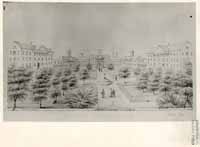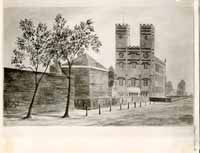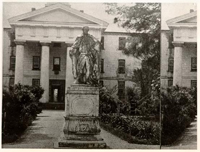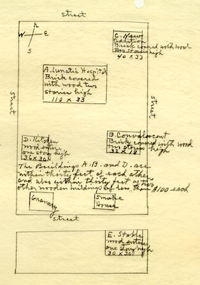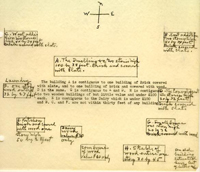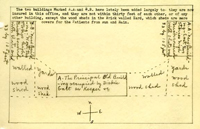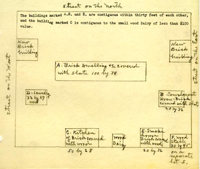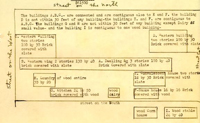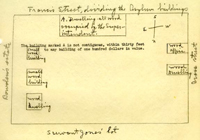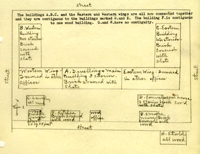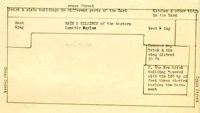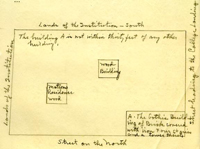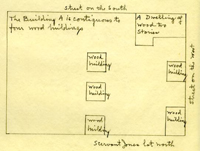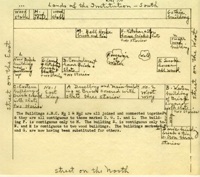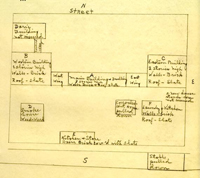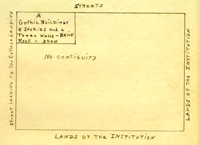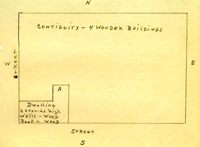Eastern State Hospital Historical Report, Block 4 Lot 80-87Originally entitled: "The Eastern State Hospital at Williamsburg, Virginia"
Colonial Williamsburg Foundation Library Research Report Series - 1078
Colonial Williamsburg Foundation Library
Williamsburg, Virginia
1990
THE EASTERN STATE HOSPITAL AT WILLIAMSBURG, VIRGINIA
THE EASTERN STATE HOSPITAL AT WILLIAMSBURG, VIRGINIA
Williamsburg has the distinction of being the site of the first insane asylum in the country.1 This hospital was built in 1773 on eight lots in the James City County portion of the city acquired from Dr. Thomas Walker,2 the noted explorer. The main building faced on Francis Street, one of the principal streets of the city. Until 1824 when a similar hospital was opened in Lexington, Kentucky, the hospital in Williamsburg, was the only hospital of its kind in the country.
Various names were given to the hospital during these years. It was called "The Mad House," "The Lunatick Hospital," "The Hospital for the Insane," "The Public Hospital," and, finally, by law, the name became, "The Eastern State Hospital."
2.That the hospital was established at this early date was, probably, due to the interest and influence of Francis Fauquier, governor of Virginia from 1758 to 1768. Fauquier was the leader in recommending to the Assembly of Virginia the great need for establishing a "Publick Hospital for Persons of Insane and Disordered Minds."
Governor Fauquier in an address to the Burgesses, on November 6 1766, recommended the establishment of "a hospital at Williamsburg for persons of disordered minds":
Thursday, the 6th of November, 7 Geo. III. 1766.
It is expedient I should also recommend to your Consideration and Humanity a poor unhappy set of People who are deprived of their Senses and wander about the Country, terrifying the Rest of their Fellow Creatures. A legal confinement, and proper Provision, ought to be appointed for these miserable Objects, who cannot help themselves. Every civilized Country has an Hospital for these People, where they are confined, maintained and attended by able Physicians, to endeavour to restore to them their lost Reason.
(Journals of the House of Burgesses of Virginia 1766-1769, p. 12)
Whereupon, the Burgesses at the session of November 20, 1766, passed this resolution.
Resolved, That an Hospital be erected for the Reception of Persons who are so unhappy as to be deprived of their reason.
Ordered, That the Committee of Propositions and Grievances do prepare and bring in a Bill, or Bills, pursuant to the above Resolutions.(Ibid, p. 33)
On April 11, 1767 the Governor again addressed the Burgesses relative to the hospital for the insane:
Saturday, the 11th of April, 7 Geo. III. 1767.
Gentlemen of the House of Burgesses,
There is a subject which gives me concern, on which I shall particularly address myself to you, as it is your peculiar province to provide means for the substinence of the poor of any kind. The subject I mean is the case of the poor lunaticks. I find on your journals that it was
Resolved, That an hospital be erected for the reception of 3. persons who are so unhappy as to be deprived of their reason. And that it was
Ordered, That the Committee of Propositions and Grievances do prepare and bring in a bill pursuant to the above resolution.
But I do not find that anything more was done in it. It was a measure which I think could offend no party, and which I was in hopes humanity would have dictated to every man, as soon as he was made acquainted with the call for it. It also concerns me much on another account; for as the case now stands, I am as it were compelled to the daily commission of an illegal act, by confining, without any authority, a poor lunatick who, if set at liberty, would be mischievous to society; and I would choose to be bound by, and observant of, the laws of the country. As I think this point of some importance to the ease and comfort of the whole community, as well as a point of charity to the unhappy objects, I shall again recommend it to you at your next meeting; when I hope, after mature reflection, it will be found to be more worthy your attention than it has been in this.(Ibid, p. 131)
No further action, apparently, was taken to establish the hospital in Williamsburg until November 1769. Fauquier had died in 1768 and Botetourt became governor of Virginia. He, too, was interested in the unhappy conditions existing as to the insane in the state. As no building had been erected, and as there were four people of disordered minds then confined in the "Public gaol" in the Colony, Botetourt asked permission of the Pennsylvania Hospital to commit these four persons. The Assembly agreed to pay for the care of these persons in the Pennsylvania Hospital until Virginia could make proper provisions for same. (Journals of the House of Burgesses, 1766-1769, p. 305)
At last, on November 15, 1769 the House of Burgesses created a committee and instructed them to draw up a bill "to make Provision for the Support and Maintenance of Ideots, Lunatics, and other Persons of unsound Minds."(Journals of the House of Burgesses of Virginia, 1766-1769, p. 259) Such bill was approved within the month, thereby establishing the desired hospital.
In June, 1770, a law was passed setting up the organization for "The publick hospital for the insane in Williamsburg" and impowering the court of 4. directors to purchase land, build the hospital and other incidentals not to exceed twelve hundred pounds:
An Act to make provision for the support and maintenance of ideots, lunatics, and other persons of unsound minds.
I. WHEREAS several persons of insane and disordered minds have been frequently found wandering in different parts of this colony, and no certain provision having been yet made either towards effecting a cure of those whose cases are not become quite desperate, nor for restraining others who may be dangerous to society:
Be it therefore enacted, by the Governor, Council, and Burgesses, of this present General Assembly, and it is hereby enacted, by the authority of the same, That the honourable John Blair, William Nelson, Thomas Nelson, Robert Carter, and Peyton Randolph, esquires, and Robert Carter Nicholas, John Randolph, Benjamin Waller, John Blair, jun. George Wythe, Dudley Digges, jun. Lewis Burwell, Thomas Nelson, jun. Thomas Everard, and John Tazewell, esquires, be, and they are hereby constituted trustees for founding and establishing a public hospital, for the reception of such persons as shall, from time to time, according to the rules and orders established by this act, be sent thereto. And the said trustees shall be called and known by the name and style of the court of directors of the public hospital, for persons of insane and disordered minds.II. And for the better and more regular ordering the business of the said hospital, the said directors shall, at their first meeting, proceed to the choice of a president, who, with any six of the other directors, shall hold a court for the dispatch of business…
III. And be it further enacted, by the authority aforesaid, That the said court of directors be, and they are hereby impowered to purchase a piece or parcel of land, not exceeding four acres, the most healthy in situation that can be procured, and as convenient as may be to the city of Williamsburg, and to contract for the building thereon a commodious house or houses, fit for the reception and acomodation of such disordered persons as are described by this act, and to provide a proper keeper and matron of the said hospital, with necessary nurses and guards, and, as occasion may require, to call in any physicians or surgeons for the assistance and relief of such poor patients, and to provide all necessaries for their comfortable support and maintenance, and in general, from time to time, to make and ordain all such rules, orders, and regulations, for the better establishing and governing such hospital, as to them shall seem fit and necessary. And for the better and more regular determining who are the proper objects of this act.
IV. …
V. …
VI. And be it further enacted, by the authority aforesaid, That the treasurer of this colony for the time being is hereby impowered and required to pay, upon the governor's warrant, to the court of directors, for purchasing the land, building the hospital, and other incidental charges, any sum or sums of money, not exceeding the sum of twelve 5. hundred pounds, and for each person removed, to be maintained and supported in the said hospital, any sum not exceeding twenty-five pounds per annum.
VII. …
VIII. …
IX. …
X. And be it further enacted, by the authority aforesaid, That this act shall continue and be In force for and during the term of five years, and from thence to the end of the next session of assembly.
(Hening's Statutes, VIII, pp. 378-381)
The Virginia Gazette of September 6, 1770, indicates that the Court of Directors appointed, met on July 10, 1770:
At a Court of Directors, appointed by the Act of Assembly, for establishing an HOSPITAL for the Reception of Ideots, Lunatics, and Persons of insane Mind, held at the Capitol the 10th Day of July, 1770.
ORDERED, that PEYTON RANDOLPH, JOHN RANDOLPH, ROBERT CARTER NICHOLAS, JOHN BLAIR, jun. and THOMAS EVERARD, Esquires, be appointed a Committee to agree on a Plan for the HOSPITAL, and to advertise the building thereof; as also to receive Proposals for that Purpose of the several Undertakers, and to make report of their Proceedings to the next Court.
JACOB BRUCE, C.C.D.The Committee appointed have, in Pursuance of the above Order, agreed on a PLan for the HOSPITAL, and are ready to treat with all Undertakers, who may incline to engage in the Work. It is to be a large, commodious Brick Building, and to be erected in or as near the City of Williamsburg as conveniently may be.
According to Mr. Siske, who had access to the Minutes of the Court of Directors, (in manuscript at the Eastern State Hospital) of date April 9, 1770, work went ahead thus:
…Using £200 that had been appropriated by the House of Burgesses they purchased eight lots, on the south side of Francis Street near the College, from Mr. Thomas Walker,1 the distinguished explorer of 6. Albermarle County. Upon these lots Ben Powell was contracted to erect a large brick building within two years, for £1,070. On April 9, 1770, Robert Smith, a Philadelphia architect, completed the plans and specifications for the Hospital.
The plans provided for a hall with a staircase and behind them a keeper's apartment and twelve other rooms chiefly for the reception of "mad people." There was a second story also with twelve rooms and a room over the Keeper's Apartment for the sessions of the Court of Directors. If necessary, this room could-be divided to make two other rooms for patients: The building was one hundred and thirty two feet, two inches wide with a front projection of three feet, six inches and was two stories high, the walls were fourteen inches thick. When it was necessary to warm the building, there were stoves fixed in the partitions of two rooms with the mouth open to the passage in which the fires were made so the "mad people" could not get to them. The chimneys came out in the roof at equal distances "to procure a good effect." The "well burnt" bricks were made near the spot, but the stone steps and window grates for the building were imported from England. The floors were of good pine plank "free from sap," and the doors were pannelled, and a modillion cornice went around the roof that was covered with cypress shingles.1
(From "A History of the Eastern State Hospital of Virginia under the Galt Family 1773-1862" by James Harding Siske, typescript, at William and Mary College.)
On January 21, 1771, a member of the Court of Directors, William Nelson, wrote to Robert Cary, merchant in London, requesting certain articles for the hospital:
7.Virginia - 1771
Robert Cary, Esq.
(Nelson Letter Book, Virginia State Library, William Nelson to Robert Cary - January 21, 1771)
The legislature of this colony has voted money to erect a Hospital for the reception and maintenance of idiots and lunatics. I have promised the gentlemen, who are to direct the building to procure such material as will be wanted from England; I therefore desire that you will send the several articles mentioned in the enclosed invoice, by the first ship, observing to insure them and place them to the account of
Your most humble servant,
William Nelson
The building of the hospital proceeded. Samuel Spurr, a bricklayer in Williamsburg, advertised for laborers to work on the hospital:
October 3, 1771.
The Subscriber will give good Wages, and Accommodations, to two or three Journey-men BRICKLAYERS, for the remaining Part of the Season, to work upon the Hospital building in this City. Plenty of Bricks and Lime is ready, so there will be no Delay.
(Virginia Gazette, Purdie & Dixon, eds.,)
SAMUEL SPURR.
The funds originally allotted for the building &c were not sufficient. The Court of Directors reported on February 24, 1772 that the lots had been purchased, plans completed, a contractor obtained, but there were not sufficient funds on hand for completion:
A Memorial of the Court of Directors of the Public Hospital for Persons of insane and disordered Minds was presented to the House, and read: representing that the Memorialists, in Compliance with an Act of the late General Assembly, took the earliest Opportunity of executing the Trust reposed in them; that they purchased eight Lots of Land in a retired Part of the City of Williamsburg, for one hundred and twelve Pounds, and agreed with an Undertaker to build such an House as they judged would best answer the Purpose; a Plan of which, with the Articles, is ready to be laid before this Honourable House; that it is hoped the Work, wherein a considerable Progress is already made, will be finished by the Time limited; and further representing, that the Memorialists, finding that what they supposed to be the Design of the Assembly could not be effected without exceeding the Sum allowed by the Act, at first Inclined to make up the difference by Subscriptions, but conceiving that might be deemed improper, engaged at all Events that the whole Money requisite should be paid, intending to lay their Proceedings before this Honourable House; and further representing, that besides the Cost of the Ground, and of the Building, when finished, amounting in the whole to about sixteen hundred Pounds, it will be necessary to inclose a Garden and Yards for Patients to walk and take the Air in; and that a Keeper and Matron must be employed, and other incidental Charges will accrue, which are not provided for by Law; and therefore humbly submitting it to the Consideration of the House to make further Provision and Establishments as they may think proper and necessary to enable the Court to carry the laudable Intention of the Assembly into complete Execution.(Journals of the House of Burgesses 1770-1772, p. 186, Monday, the 24th of February, 12 George III. 1772)
On the February 27th, 1772 session of the House of Burgesses, the above Memorial was acted upon:
Resolved, That it is the Opinion of this Committee, that a Sum of Money, not exceeding eight hundred Pounds, be paid by the Treasurer, upon the 8. Governor's Warrant, to the Court of Directors of the Hospital for Ideots, Lunatics, and Persons of insane and disordered Minds, to be by them laid out in finishing the said Hospital, and making proper Inclosures for the Patients to walk, and take the Air in.
The said Resolution being read a second Time was, upon the Question put thereupon, agreed to by the House.1
(Ibid,, p. 197)
The first bequest to the Hospital was in 1772 when one hundred pounds was left by William Nelson, one of the original trustees:
"…I give and bequeath to the Court of Directors appointed by Act of Assembly to errect and superintend the Public Hospital for the reception of Lunatics, etc. the sum of One hundred pounds current money to be by them applyed towards the farther relief of such Patients as may be sent to the said Hospital as they, in their discretion, may think fit but not to the enlargement of the Building or to any other purpose…"(Will of William Nelson, copy in Virginia Historical Magazine, XXXIII, p. 191)
The hospital was completed by September 14, 1773 and was to be opened for patients on October 12th:2
9.Williamsburg, September 14, 1773
THE PUBLIC HOSPITAL, established by an act of the General Assembly for the reception of ideots, lunaticks, and other persons of unsound minds, being now compleated, notice is hereby given that the court of directors will meet at the said hospital on Tuesday the 12th of October next, to receive all such persons as may be sent thereto, according to the directions of the said act, and that the court, for the same purpose, and the better ordering the general business of the hospital, will meet on the same day in every succeeding week, till farther notice.
It is hoped that the magistrates in the several counties will in every instance distinguish between such persons as have no estates and those who are able to defray the whole or part of the expence of their support and maintenance as the law requires, and that none but such as are proper object of the act of Assembly will be sent to the said hospital. By order of the court of directors.
(Virginia Gazette, Rind, ed., September 16, 1773.)
JACOB BRUCE, Clerk.
Charge for the maintenance of the first patients was £15 per year. Thirty-six patients were admitted and the Assembly allowed £25 for the support of each patient; and 20s. was allowed the sheriff for summoning the justices and witnesses for the examination of each patient and 5lbs. of tobacco per mile for bringing the patient to the hospital. Guards were paid this amount also. (Annual Report of the Eastern State Hospital, 1913, p. 6)
The officers appointed in September, 1773, were: James Galt,1 keeper, and Dr. John De Sequeyra,2 visiting physician. Galt served twenty seven years until his death in 1800. The first president of the Court of Directors was John Blair, 1769-1770, who was succeeded by William Nelson, 1771-1772, General Thomas Nelson, 1772-1786; Dudley Digges, 1786-1788; Rev. James Madison, 1788-1790; Rev. John Bracken, 1790-1791 and Rev. Doctor James Madison, 1791-1801. (See: Tyler's Williamsburg p. 244)
From time to time, as the original Court of Directors of the Hospital died or resigned, their places were filled by such prominent citizens of Williamsburg and Virginia as Edmund Randolph, Joseph Hornsby, William Pasteur, Robert Saunders, Benjamin Harrison, Philip Barraud, M. Anderson, Charles Hunt, George Carter, and others.
10.Ebenezer Hazard, a traveller to the south in 1778, reported in his "Journal" his impression of Williamsburg and its buildings. His comment on the Hospital follows:
The Mad House is a three Story Building, but as I did not choose to have my Humanity shocked by a sight of its wretched Inhabitants, I did not go into it.(Journal of EBENEZER HAZARD'S Journey to the South, 1778 - Original Ms. in Historical Society of Pennsylvania)
In July 1781 several citizens of Williamsburg who were also members of the Court of Directors of the Public Hospital, wrote to Governor Nelson as to the conditions at the Hospital largely brought about by the arrival of British troops in the city:
JOHN BLAIR, NATH'L BURWELL, JOHN DE SIQUEYRA, J: MADISON, AND J. PRENTIS, TO GOV'R NELSON.
Sir,
We think it a Duty incumbent upon us, to lay before you ye present state of ye Hospital for Lunatics — It is destitute of every necessary for its support — The unhappy objects which are now here have been without cloathes for some time past — they are now also without Provisions — The Keeper, previous to ye Arrival of ye British Army at this Place obtain'd Provisions from ye Commissaries by means of an order from Gov'r Jefferson for that Purpose — But at present there is no such officer here, & therefore that Resource is at an end — We submit this state to your Excellency, because we doubt not, if it be possible, that you will make such Provision for ye unhappy sufferers as is absolutely requisite, by supplying them with proper cloathing & by enabling ye Keeper to draw Provisions from such Commissaries as may be appointed at this Place, or at any Place convenient to it.We have enclosed a List of ye Persons now in ye Hospital & have added the Counties from whence they were sent, in Hopes that your Excellency will order ye means of returning them to their respective Counties provided no method can be adopted for their support.
(Calendar of Virginia State Papers, II, P. 279)
We are Sir
Your most obet Servants.
In 1781 the French soldiers were in Williamsburg. Among the troops was Preudhomme de Borre. He wrote his impressions of Williamsburg thus:
…Toward the center of the city (and at about the height of the second street), is the Governor's Palace, very well built, very spacious, with a big lawn extending to the second street which forms a pretty avenue. On the opposite side is a very fine edifice which is the Insane Asylum…(Preudhomme de Borre, Ms.-Enclosure No. 2 to Memorandum No. 303 Archives Nationales, Marine B4 144 Translation by Warrington Dawson, copy in "General Description of Williamsburg" Research Department.)11.
The Hospital had been used as barracks during the Revolutionary War.(Prison Discipline Society, Annual Report, 1841, Boston, p. 8)
Little is known as to what actually happened to the hospital and its Inmates in the period from 1781-1784. It is presumed that the patients, perhaps, were returned temporarily to the counties until some action could be taken by the Governor and Assembly. In January and February, 1784, letters from Dr. Sequeyra and Dudley Digges to the Governor throw some light on this matter:
John De Sigueyra to Gov: Harrison. Jan'y 15th[1784]
Sir
(Calendar of Virginia State Papers, III, P. 555)
…I must acquaint you, that from the October Session of Assembly in 1769 to Nov: 1781, the Hospital for Lunaticks being then broke up, I have not received my salary of fifty pounds a Year as Physician to the said Hospital, and a hundred pounds is due me as it will appear by the Auditor's Books. As the Assembly passed an Act & resolution that the Arrears of the Said Hospital should be paid out of the money appropriated for the Civil List, your Excellency will be so good to give a warrant to the Treasurer for the payment of the Sd: Sum, &c.
Dudley Digges, Pres: Board of Directors, to Gov: Harrison
Feb'y 3th
(Ibid, p. 558)
Enclosing the proceedings of "Court of Directors of the Public Hospital for Lunatics," present, Dudley Diggs, James Madison, Thos: Nelson, John Blair, John de Sequery, Nathl: Burwell and J. Prentis Esquires, authorizing him to call upon the Executive for an order on the Auditor of Public Accounts, for Three hundred Pounds, in favor of James Galt, the late keeper,1 and for the "further Sum of fifty pounds for the immediate relief of such lunatics as are now in town." These amounts to be credited to the late appropriations made by the General Assembly.
In September 1784, an additional amount was requested by Digges of one hundred and fifty pounds. (Ibid p. 612)
From these funds, the Directors began plans to repair the hospital so that patients could be accepted and made comfortable again. In October 1786, Digges reported the work of the Directors in this matter: 12.
Dudley Digges to Hon. J. Ambler, Esq. October 13th (1786)
Sir:
(Ibid. IV, P. 178)
The Court of Directors have at length effected the repairs of the Hospital for Lunatics, &c., and put it in a proper Condition to receive some unhappy Patients who have long suffered for want of this humane Asylum, established and intended by the Legislature of our Country for their benefit and support. In doing this, however, the whole sum of two hundred pounds, lately received from the Treasury, hath been exhausted; and therefore the Court of Directors have come to a Resolution, which I have now the honor to enclose, requiring Mr. Joseph Hornsby, Treasurer to the said Hospital, to draw on you for the sum of four hundred pounds, being the balance of six hundred pounds voted by the Gen'l Assembly for the purpose of supporting this same Hospital, &c.
A visitor to Williamsburg in writing to his wife on November 18, 1786, had this impression of the hospital:
…here is a large handsome brick Mad House (for Lunaticks &c)— all the public buildings except the Mad House, are in a decaying situation, as most of the Private buildings…(William and Mary Quarterly, XVII, Series 2, p. 238)
Several accounts for repairs to the Hospital are preserved in Ms. Ledgers of Humphrey Harwood, Williamsburg carpenter and brick mason. The accounts range from 1786 through 1794. There were charges such as white-washing rooms, stairway, passages, closets, kitchen, laying bricks, plaistering dairy, repairing door frames, mending oven &c. (See: Illustration #2, Appendix, for copy of accounts from Harwood's Ledger)
An act passed in December 1790 gave authority to the Court of Directors of the Hospital "to cause to be constructed three additional cells to the said hospital, and also to have such outhouses erected as may appear to them necessary. And the auditor of public accounts is hereby directed to grant to the said court of directors, a warrant on the treasurer for any sum of money not exceeding one hundred pounds, to be paid out of any public money in his hands, for the purpose of defraying the expences of constructing and erecting the same…" (Hening's Statutes, XIII, p. 128) Such account for outhouses &c was ordered paid in March 1791. (Calendar of Virginia State Papers, V, p. 277)
13.Rochefoucauld described the hospital as he saw it while in Williamsburg ca 1795:
Il y a en outrê à Williamsburg un hopital pour les fous; il est soutenu par le tresor public. C'est un beau bâtiment où les fous sont plutõt abandonnês à leur malheureuse existence que traitês pour les en tirer. Les observations faites en Virginie sur ces maladies leur donnent pour causes principales la devotion et les liquers spiritueses et dêmontrent que le derniere de ces causes est moin incurable que l'autre. Il n'y a que quinze fous ou folles dans cet hõpital, qui en puet contenir trente. (William and Mary Quarterly Second Series, X p. 82, from Voyage dans les Etats-unis d'Amerique fait en 1795, 1796 et 1797, V, 4, p. 286-296)
Isaac Weld observed that "…There is an hospital here [Williamsburg] for lunatics, but it does not appear to be well regulated…"(Travels through the States of North America and the Provinces of Upper and Lower Canada during the years 1795, 1796, and 1797, pp. 94-96)
St. George Tucker, a citizen of Williamsburg, described his city in 1796. Of the hospital he wrote as follows:
…The hospital for lunatics is calculated to accommodate between twenty and thirty patients in separate rooms, or cells, They have, I believe, never been all filled at the same time; the house is neatly kept, and the patients well attended; but convalescents have not sufficient room for free air, and exercise, without danger of making their escape…(William and Mary Quarterly, II, p. 194, from a Letter addressed to the publishers of the American edition of Winterbotham's, History of America)
Maps of Williamsburg during the latter part of the eighteenth century indicate the hospital thus:
The Frenchman's Map (1782) gives "Maison des fous" with drawing like this:

Rochambeau's Map (1781) gives "Maison de fous"
The College Map (1791?) gives "Bedlam Madhouse" and lots numbered 80, 81, 82, 83, 84, 85, 86, 87.
Bucktrout-Lively Map (1867) given "Madhouse" and lots are numbered as above.
(See: Copies of Map, Research Department)
The earliest insurance policy available is dated 1821, Mutual Assurance Society. The "Lunatic Hospital" is described as of brick covered with wood 110 by 33 feet, two stories, convalescent house of brick 32 by 18 feet, a new 14. addition of brick, two stories 40 by 33, kitchen of wood entire 36 by 30 feet a granary and a smokehouse. (See: Illustration #3 for copy of policy #1640 in full)
In 1830 another policy for the hospital and buildings refers to the main building as "The Dwelling &c" 2 stories high 100 by 38 feet, brick covered with slate; east addition 40 by 34 feet; West addition 40 by 34 feet; convalescent house 20 by 32 feet; laundry 32 by 27 feet; kitchen 50 feet by 28 feet; dairy, stable, smokehouse — (See: Illustration #3, copy of policy #6023)
By 1835 the keeper, Dickie Galt, was occupying the principal building. (Illustration #3, policy #8320) In 1841 the keeper's title was changed to "superintendent." At this time Dr. John Galt was offered the position at the early age of twenty-two, and accepted. Dr. Galt was highly educated: a graduate of William and Mary College and of the Medical School of Philadelphia. Dr. Galt was among the first to recognize the value of employment in the treatment of the insane. His book, Treatment of Insanity (1846) is outstanding in its humane treatment of patients. The Annual Report of the Eastern State Hospital (1843) gives Dr. Galt's ideas as to treatment, amusements, and the supposed causes of insanity. Dr. Galt compiled Practical Medicine (1843) chiefly from notes and case histories left by his father, Alexander D. Galt. Other published works were: Essays on Asylums for Persons of Unsound Mind (1850), Essays (1853) Insanity in Italy (1854), and A Lecture on Idiocy (1859). For further information about Dr. John M. Galt II and his family — see Blanton's Medicine in Virginia in the Eighteenth Century, and also, Medicine in Virginia in the Nineteenth Century; and The Galt Families by Howard Spilman Galt (1938).
Dr. Galt, superintendent of the hospital, advertised in a Richmond newspaper on May 31, 1844 for proposals "for erecting three large Porticos 15. and one Smaller one, to the building of the Asylum. In the meantime, a plan and detailed description of the work may be seen on application to the Superintendent, at the Asylum."(Richmond Enquirer, May 31, 1844)
Insurance policies for 1835, 1839 and 1846 indicate that changes and expansions were going on at the Hospital. The 1846 policy (#14,389) indicates that the original building had been connected to the eastern and western buildings by wings. (See: Illustration #3 for copies of policies)
By 1846 a house had been acquired as a dwelling house for the superintendent of the hospital. This property was located across Francis Street from the main entrance to the hospital, was built by Edward Champion Travis1 (ca 1765) and owned continuously by the Travis family until 1846. The house was insured under policy #14,390 and faced on Francis Street south, with Scervant Jones' lot to the north, Bowden's estate to the east and a cross street west.2
In 1853 a policy (#17,639) shows the usual buildings as described above; and an additional new building called "Doric building" three stories high, was joined to the Western building by a covered way. (Illustration #3) There was also a building known as "Gothic Building."
Three policies for the year 1860 complete the picture so far as insuring the hospital is concerned. (Illustration #3 for copies of these policies)
During the Civil War at various times the Hospital for the Insane in Williamsburg fell into the hands of the Federal troops.3 The circumstances relating to these changes can be found in Calendar of Virginia State Papers, Vol. XI, pp. 212, 236-7, 263, 276-7, 379, 396 and 457-8. (See Illus. #4 for items from Sweats Index as to changes)
Samuel E. Mayes In his Diary (1862) remarked on the hospital at Williamsburg thus 16.
The Asylum at Williamsburg is a very large and imposing Building, but nothing beautiful about it.(Tyler's Quarterly Magazine, VI, p. 31)
Mrs. Victoria Lee in writing of Williamsburg as she remembered it in 1861 made this statement about the superintendent's house at the hospital:
Back of the Main Building [of the Eastern State Hospital] was a small frame, story and a half cottage known as the Galt House. I remember this house very well because I lived there for seven or eight years. It was built on a hill with deep cellars. Two stone steps led to the front door. This house at that time did not have the small porch that it now has since its restoration.(Ms. Mrs. Victoria Lee, Typescript in Research Dept.)
Mr. John Charles states in his "Recollections of Williamsburg" during this period:
The old and well preserved story and half building with basement and dormer windows, now on hospital grounds southwest of the infirmary, was once the home of the "Galts," and faced then on Ireland Street.(Ms. Mr. Charles, Typescript in Research Dept.)
In December 1865 it was resolved that the committee on Lunatic Asylums of the General Assembly of Virginia have leave to visit the Asylums with power to send in a report as to their findings. The proceedings of the House of Delegates and the work of the committee appointed for the investigation of the management of the eastern lunatic asylum, is recorded in the Calendar of Virginia State Papers, pp. 471-497.
In 1884 the Board of Directors advertised in a Richmond newspaper that the hospital at Williamsburg was better fitted for receiving patients:
The Board of Directors of the Eastern Lunatic Asylum, in Williamsburg, inform the public, that a new building has just been added to the establishment, which renders it complete for all the important purposes of comfort and care especially in the particular of Classification.
The Institution is now furnished with every Modern improvement, and under the most skillful and scientific superintendence - and is completely fitted to receive not only such patients as are supported by the State, but any whose friends may choose to place them in it as boarders.
(Richmond Enquirer September 3, 1884)
Dr. Tyler states that "the old hospital building was destroyed by fire in June 1885, and it is believed that none of the first structures are now 17. standing except a small frame house, within the grounds, formerly the residence of Superintendent James Galt." (Tyler, Williamsburg, p. 244)
The Eastern State Hospital has had three disastrous fires in its history according to the 131st Annual Report:
...On the 8th of January, 1876, fire destroyed the building in which were the chapel, amusement hall, store room, kitchen, bakery and dining rooms for employees. The estimated value of the property destroyed was $16,404. Nine years later, on June 7, 1885, a most disastrous fire occurred, destroying the centre building with its wings, also a building known as the 'white house'; the centre building was the original building completed on the 14th of September, 1773, with additions. Almost at the beginning of another century, January 4, 1902, the 'tower building,' erected in 1844, was destroyed by fire.
All of these buildings have been replaced by large, convenient and substantial structures, not connected but at convenient distances apart giving the entire group an airy and attractive appearance."
(The One Hundred and Thirty First Annual Report of the Eastern State Hospital, p. 18, published In 1904.)
| Illustration #1: | Tyler's Adaptation of the College Map. |
| Plan of hospital drawn from specifications made by Robert Smith in 1770. | |
| Photostats of buildings as they appeared in 1773, 1840, 1855. | |
| Illustration #2: | Accounts from Humphrey Harwood's Ledger. |
| Illustration #3: | Copies of insurance policies (1821-1860) |
| Illustration #4: | References to Eastern State Hospital from Swem's Virginia Historical Index. |
Mary Stephenson
Footnotes
Thomas Walker was the son of Thomas and Susanna Peachey Walker. He was born in 1715, educated at William and Mary College, and was a merchant and Surveyor. In 1748 Walker went on an expedition to Kentucky and kept a diary of his trip. In 1753 Colonel Joseph Fry recommended the discovery of a route to the Pacific coast, and Dr. Walker was to be the chief conductor of the enterprise. From 1752 to 1754 Walker was a representative in the House of Burgesses for Louisa County. From 1757 to 1761 Walker represented Hampshire County in the House of Burgesses, after which time he changed his residence to the east and represented Albemarle County from 1761 to 1772. In 1775 and 1776 Walker was a member of the revolutionary conventions, and was a member of the committee of safety for the colony in 1775. In 1777 Walker was a member of the Council of state, and in 1779 was chief of the commissioners on the part of Virginia to meet the commissioners from North Carolina to run the boundary line between the two states. During the war and for some years after it, he was a member of the house of delegates of Virginia. Walker was an Intimate friend of Jefferson. He died in 1794 at his residence Castle Hill In Albemarle County.
As the records of James City County were destroyed by fire during the Civil War, no court records are available which throw any light on the lots held by Walker in Williamsburg. So far as the writer knows, the above quoted Annual Report is the only source which establishes Walker's ownership of the eight lots on which the hospital is now located.
See: Illustration #1, Lyon G. Tyler's map of Williamsburg, adaptation of the College Map.
See: copy of plan, Illustration #1.
In Blanton's Medicine in Virginia in the Eighteenth Century, p. 278, is a ground plan and elevation for the first hospital for idiots and lunatics in Williamsburg. Source is not given.
M-82-15
(Near end of reel)
typed 4 pages from Greenbriar Independent:
"Letter from Williamsburg, Virginia
College of William and Mary.
August 20th, 1879.
Editor Greenbriar Independent:
"…Since I have been in Williamsburg the gentlemanly Superintendant, Dr. Black repeatedly shown me through the Eastern Lunatic Asylum, founded in 1773…Mr Mercer the polite and obliging clerk and store-keeper of the Asylum, informed me there are now three hundred and twenty patients here… They are now building a three-story brick house, 46 x 120 foot… another the same size [to be built] After these two buildings shall have been completed they will be able to accommodate four hundred and seventy-five patients. They are introducing the telephone at this Asylum…
…
A.M.N."
LIBRARY OF CONGRESS — MANUSCRIPTS DIVISICN
VIRGINIA MISC. MSS. Box 2.
1788, Oct. 31. Williamsburg Hospital for the Insane — Minutes of Directors Meeting. (State has not paid quota &c.)
E. S. Hospital (J.Hemphill)
Illustration #1
 Photostat copy of the Williamsburg Plat in "Williamsburg the Old Colonial Capitol" by Lyon G. Tyler
Photostat copy of the Williamsburg Plat in "Williamsburg the Old Colonial Capitol" by Lyon G. Tyler
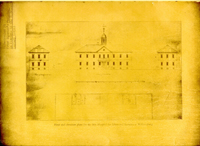 Floor and elevation plans for the first Hospital for Idiots and Lunatics at Williamsburg
Floor and elevation plans for the first Hospital for Idiots and Lunatics at Williamsburg
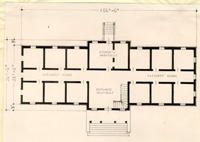 Hospital for the Insane
Hospital for the Insane
Building Designed by Robert Smith
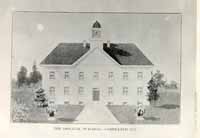 The Original Building - Completed 1773
The Original Building - Completed 1773
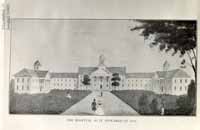 The Hospital As It Appeared in 1840
The Hospital As It Appeared in 1840
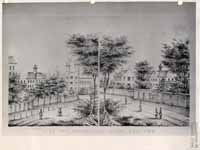 Hospital (1855)
Hospital (1855)
West View Eastern Lunatic Asylum.
Illustration #2
Hospital Report
HARWOOD LEDGER B p. 130
| THE HOSPITAL FOR LUNATICS | Dr | ||
| 1788 | th | ||
| Octor | 13 | To 4 bushels of lime 4/. & mending plastering 3/6 | £ -. 7. 6 |
| To 1 peck of Hair /6 & 1 days labour 2/6 | -. 3. - | ||
| To mending Back 3/. | -. 3. - | ||
| £ 0.13.6 | |||
| See posted 36 fol: Ledger C. | £ 0.13. 6 |
| The Public for ye Hospital of Lunatics | Dr | |||
| 1786 | nd | |||
| August | 22 | To 2180 Larthes a 1/6 per C & 4250. 4d nails a 4/. | £ 2. 8.6 | |
| To 152 bushels of lime a 1/. & 6 bushels of Hair a 2/. | 8. 4.- | |||
| To carting 5 loads of sand a 2/. & 17 day's labour a 2/6 | 2.12.6 | |||
| To 43 days work a 6/. — Repairing larthing & plastering; turning Trimers, laying Hearths & mending Chimnies | 12.18.- | |||
| To 2334 Bricks a 3/. Per C & 14 bushels of Whitewash a 2/ | 4.18.- | |||
| To White-washing 27 Rooms a 5/6 | 7. 8.6 | |||
| To … do | passages 60/ | 3. -.- | ||
| To cutting through Wall & working in Door frame | -.12.- | |||
| To 2 days labour a 2/6 & 30 bushels of lime | 1.15.- | |||
| Sepr | 4 | To 2800 Bricks 60/. & 8 bushels of lime 8/. | 4.12.- | |
| To cutting out cellar door frame & working in one 5/. | -. 5.- | |||
| To do three window frames a 2/6 | -. 7.6 | |||
| To Repairing Well 15/. & rebuilding Oven 22/6 | 1.17.6 | |||
| To do underpinning to Smoke-House & Stable 5/. & 22 busl lime @ 1/. | 1.7 | |||
| To laying Kitchen floor & Hearth 30/. & repairing passage 3/. | 1.13.- | |||
| To larthing & plastering 25 yards in Dairy & passage a 6d½ | 16.6 | |||
| To White-washing Kitchen, Dairy & passage 20/. | 1. 5.- | |||
| To 10 Days labour a 2/6 | £56.17.0 | |||
| £56.17.0 |
| THE HOSPITAL (FOR LUNATICS) | Dr | Cr | ||
| 1790 | th: | To amt brt from folo Bo[ok] ante Led:B | £ -.13.6 | |
| April | 28 | To 1 peck of Whitewash 3¾ | £ -. -.3¾ | |
| To whitewashing 1 Room 3/9 [illegible] | 3.9 | |||
| Augt | 7 | To 6 bush: of whitewash a 1/3 | 7.6 | |
| To whitewashing 12 Rooms a 3/9 | 2. 5.- | |||
| To do 2 passages a 4/. & 2 Clossets a 2/6 | -.13.- | |||
| To do ye stairway 2/. | 2.- | |||
| To 10 bushels of lime a 9d & 160 Bricks a 2/6 | 11.10¾ | |||
| To mending plaistering in the Rooms & Brick-work round the Door 7/6 | 7.6 | |||
| To laying an Hearth 2/6 | 2.6 | |||
| Octor | 13 | To 8½ bushels of lime a 9d | 6.4½ | |
| To mending plaistering & working in a door Frame &c 7/6 | 7.6 | |||
| £ 6. 0.10 | ||||
| Drawn off | ||||
| By the above, not settled of 13/6 | ||||
| As the acct had not been audited | 13.6 | |||
| 5. 7.4 | ||||
| By Cash 27th Jan: 1790 of Jo. Hornsby | 5. 7.4 | |||
| £ 5. 7.4 | £5.7.4 |
| HOSPITAL OF LUNATICS | Drs | ||
| th | |||
| 20 | To mending Oven & ½ Bushl Lime | -.1.6 | |
| [crossed out] | 13.6.- | ||
| 1794 | To 51 Barrells do a 14 | 39.4 | |
| April | 23 | To ¾ of a days Hire of Nat | 4.1½ |
| Carried to Folio (14) |
| 1794 | th | THE HOSPITAL OF LUNATICS | Dr | Cr |
| £ S D | ||||
| Feby | 19 | To 1 days Hire of Nat & 2 bushls Lime @ 9d | 0 5 6 | |
| March | 3 | To whitewashing one Room @ 3/. & ½ bushl Whitewash | - 4 - | |
| To mending Oven ½ Bushl Lime @ 9d | - 1 6 | |||
| April | 23 | To ¾ of a days Hire of Nat @ 4/. | - 3 - |
Illustration #3
Hospital
May 25, 1821.
New
No. 1640
I the underwritten Roscow Cole, Treasurer of the Lunatick Hospital residing at Williamsburg in the county of James City do hereby declare for assurance in the Mutual Assurance Society … The Hospital buildings on the lands belonging to the State of Virginia now occupied by the Keeper of the Lunatick Hospital situated between streets on every side thereof in the County of James City…
| The Lunatick Hospital | marked A at | $15,000 |
| The Convalescent | marked B at | 1,500 |
| The New Addition | marked C at | 4,000 |
| The Kitchen | marked D at | 200 |
| The Stable | marked E at | 120 |
| $20, 820 |
January 5, 1830
No. 6023 Revaluation of Buildings declared for Assurance by [the Mutual
Assurance Society) as per Declaration No. 1640.
WE the underwritten Robert Anderson Special Agent, and Thomas Sands and Jesse Cole Appraisers, Do hereby Certify, that we have viewed and revalued, the Buildings heretofore declared for Assurance, in the Mutual Assurance Society… That the said Buildings are at present owned by the state of Virginia residing at and occupied by Dickie Galt That they are situated on Land belonging to the State of Virginia, and used as an Hospital for persons of unsound mind, being on the southwest of the City of Williamsburg in the County of James City…
| The Dwelling &c | marked A at | $11,000 |
| The East Addition | marked B at | 5,000 |
| The West Addition | marked C at | 5,000 |
| The Convalescent | marked D at | 2,500 |
| The Kitchen | marked E at | 2,500 |
| The Laundry | marked F at | 500 |
| The Smoke House | marked G at | 200 |
| The Stable | marked H at | 400 |
| $27,100 |
The building A is contiguous to one building of Brick covered with slate, and to one building of brick and covered with wood. D is the same. G is contiguous to A and D. H is contiguous to two wooden buildings of but little value and under $100 each. E is contiguous to the Dairy which is under $100 and B. C. and F. are not within thirty feet of any building.
August 12, 1835
No. 8320 Revaluation of Buildings formerly declared for Assurance in the Mutual Assurance Society per Declaration No. 6023
I the underwritten Jesse Cole, Treasurer of the Lunatic Hospital in Williamsburg residing at Williamsburg in the county of James City do hereby declare for Assurance in the Mutual Assurance Society… the buildings on the lands of the Lunatic Hospital in Williamsburg now occupied by Dickie Galt, Keeper of said Hospital situated between streets on the East, West, North and South in the county of James City…
| The New Building East | marked A at | $l2,000 |
| The New Building West | marked B at | 12,000 |
| $24,000 |
The two buildings Marked A.A.and B.B. have lately been added largely to- they are now insured in this office, and they are not within thirty feet of each other, or of any other building, except the wood sheds in the Brick walled Yard, which sheds are mere covers for the Patients from sun and Rain.
April 24, 1839
No. 11,008 Revaluation of Buildings declared for Assurance by the Court of
Directors of the Lunatic hospital as per Declaration No. 6023
We the underwritten Robert Anderson Special Agent, and Lucius P. Cary and Albert G. Southall Appraisers, Do hereby Certify, that we have viewed and revalued, the Buildings heretofore declared for Assurance, in the Mutual Assurance Society against Fire… as per its Declaration for Assurance, Numbered 6023, That the said Buildings are at present owned by the state of Virginia residing at Virginia and are occupied by Philip J. Barziza, keeper of the institution That they situated on streets East, West, North and South in the City of Williamsburg
| The Dwelling &c | marked A at | $12,500 |
| The Convalescent House | marked B at | 2,000 |
| The Kitchen | marked C at | 2,500 |
| The Laundry | marked D at | 500 |
| The Smoke House | marked E at | 300 |
| The Stable | marked F at | 700 |
| $18,500 |
The buildings marked A.B. and E. are contiguous within thirty feet of each other, and the building marked C is contiguous to the small wood Dairy of less than $100 value.
1843, January 23rd.
Mutual Assurance Society policy No. 11264 revaluation of Buildings formerly declared for Assurance by the Court of Directors of the Lunatic hospital per Declarations No. 8320 & 11008
I the underwritten Robert Saunders president and on behalf of the Directors of the Eastern Asylum for the maintenance and care of insane persons residing at Williamsburg in the county of York do hereby declare for Assurance … the buildings on land belonging to the Eastern Asylum for the maintenance and cure of insane persons now occupied by the Agents and patients thereof situated between streets on the East, West, North and south In the City of Williamsburg in the county of James City…
| The Dwelling &c | marked A at | $13500 |
| The Western wing | marked B at | 18000 |
| The Eastern building | marked D at | 12000 |
| The Western building | " C at | 12000 |
| The Convalesant house | " E at | 2000 |
| The Smoke house | " F at | 300 |
| The Kitchen | " G at | 2500 |
| The Laundry | " H at | 500 |
| The Stable | " I at | 700 |
| $61500 |
The buildings A.B.C.- are connected and are contiguous also to E and F. the building D is not within 30 feet of any building-the buildings E. and F. are contiguous to A.B.C- The buildings G and H are not within 30 feet of any building except Dairy of small value- and the building I is contiguous to one wood building-
October 27, 1846
No. 14,390 Revaluation of Building formerly declared for Assurance by William Edloe & the Eastern Asylum per Declaration No. 10736
I the underwritten President and Directors of the Eastern Asylum for the Maintenance and cure of Insane persons residing at Williamsburg in the county of do hereby declare for Assurance in the Mutual Assurance Society against Fire… The Building of the Institution now occupied by the Superintendent of the same, situated between the lands of Servant Jones on the north and streets on the South and West in the county of James City…
| The Dwelling | marked A at | $2500 |
| $2500 |
The building marked A is not contiguous, within thirty feet to any building of one hundred dollars in value.
October 27, 1846
No. 14,389 Revaluation of Buildings formerly declared for Assurance by the President and Directors of the Eastern Asylum for the maintenance and cure of Insane Persons residing at Williamsburg in the county of do hereby declare for Assurance in the Mutual Assurance Society…the Buildings of the Institution on lands belonging thereto now occupied by its Officers and assistants & patients situated between streets principally on all sides in the county of James City…
| The Dwelling & main building | marked A at | $18,000 |
| The Western Building | marked B at | 12,000 |
| The Eastern Building | marked C at | 12,000 |
| The Convalescent House | marked D at | 2,000 |
| The Smoke House | marked E at | 300 |
| The Kitchen | marked F at | 2,500 |
| The Laundry | marked G at | 500 |
| The Stable | marked H at | 500 |
| $47,800 |
The buildings A.B.C. and the Eastern and Western wings are all now connected together and they are contiguous to the buildings marked D. and E. The building F. is contiguous to one wood building. G and H. have no contiguity.
M-153-2 Brock Collection
Mutual Assurance Policy on Eastern Lunatic Asylum
August 19, 1850
…A building on the land of the Eastern Lunatic Asylum now occupied by the Officers & patients of the institution situated between the four cross streets in the City of Williamsburg surrounding the principale buildings in the county of James City & City of Williamsburg…
| The New Building | A at | $20,000 |
September 24, 1853
No. 17,638 Revaluation of Building declared for Assurance by the President & Directors of the Eastern Asylum for the Maintenance and cure of Insane Persons as per Declaration No. 269 A
We, the underwritten Robert Anderson Special Agent, and John A. Deneufville and William S. Peachy Appraisers, do hereby certify that we have viewed and revalued the Building heretofore declared for Assurance in the Mutual Assurance Society against Fire … by The President & Directors of the Eastern Asylum for the Maintenance and cure of Insane Persons as per their Declaration for Assurance, numbered 269
That the said Building is at present owned by the Institution and is occupied by its Assistants and patients residing at Williamsburg That it is situated on the land of the Institution in Williamsburg in the County of James City…
| The Gothic Building | marked A at | $18200 |
| $18200 |
September 24, 1853
No. 17,640 Revaluation of Building declared for Assurance by the Presidents & Directors of the Eastern Asylum for the maintenance and Cure of Insane persons as per Declaration No. 14390
We, the underwritten Robert Anderson Special Agent, and John A. Deneufville and William S. Peachy Appraisers, do hereby certify that we have viewed and revalued the Building heretofore declared for Assurance, in the Mutual Assurance Society against Fire…
That the said Building is at present owned by the Institution residing at Williamsburg and is occupied by the Superintendent That it is situated on the land of the institution in Williamsburg on streets South and west and Servant Jones lot on the North in the County of
| The Dwelling | marked A at | $2500 |
| $2500 |
September 24, 1853
No. 17,639 Revaluation of Buildings declared for Assurance by the President & Directors of the Eastern Asylum for the Maintenance and Cure of Insane Persons as per Declaration No. 14389
We the underwritten Robert Anderson Special Agent, and John A. Deneufville and William S. Peachy Appraisers, do hereby certify that we have viewed and revalued the Buildings heretofore declared for Assurance, in the Mutual Assurance Society against Fire… That the said Buildings are at present owned by the Institution and are occupied by the Assistants and patients residing at Williamsburg in the County of James City County…
| The Dwelling & Main building | marked A at | $18,000 |
| The Western Building | marked B at | 12,000 |
| The Eastern Building | marked C at | 12,000 |
| The Convalescent House | marked D at | 2,000 |
| The Smoke House | marked E at | 300 |
| The Kitchen & Store house | marked F at | 5,000 |
| The Laundry and Kitchen | marked G at | 5,000 |
| The Stable | marked H at | 250 |
| The Doric building | marked I at | ...... |
| $54,650 |
The Buildings A.B.C. No 1 & No 2 are all joined and connected together & G. I. and they are all contiguous to those marked D. G. I. And L. The building F. is contiguous only to M. The building E. is contiguous only to N. and H is contiguous to two wood buildings. The buildings marked E. F. and G. are now having been substituted for others.
December 31, 1860
No. 21,329 Revaluation of Buildings declared for Assurance by the President & Directors of the Eastern Asylum for the maintenance and cure of Insane Persons as per Declaration No. 17639
We, the underwritten Walker W. Vest & Parkes Slater Appraisers, do hereby Certify that we have viewed and revalued the Buildings heretofore declared for Assurance in the Mutual Assurance Society against Fire… That the said buildings are at present owned by the Institution residing at Williamsburg and are occupied by the Assistants & Patients That they are situated on the land of the Institution in the said City of Williamsburg and in the County of James City…
| The Dwelling & Main Building | marked A at | $18,000 |
| The Western Building | marked B at | 12,000 |
| The Eastern Building | marked C at | 12,000 |
| The Smoke House | marked D at | 300 |
| The Kitchen & Store House | marked E at | 5,000 |
| The Laundry & Kitchen | marked F at | 5,000 |
| $52,3000 |
December 31, 1860
No. 21,328 Revaluation of Building declared for Assurance by the President & Directors of the Eastern Asylum for the maintenance and cure of insane persons as per Declaration No. 17638
We, the underwritten Walker W. Vest & Parkes Slater Appraisers, do hereby certify that we have viewed and revalued the Buildings heretofore declared for Assurance, in the Mutual Assurance Society against Fire… That the said Building is at present owned by the Institution residing at Williamsburg and is occupied by the Assistants & Patients. That it is situated on the land of the Institution in the said city of Williamsburg and in the County of James City…
| The Gothic Building | marked A at | $18,200 |
| $18,200 |
December 31, 1860
No. 21,330 Revaluation of Building declared for Assurance by the President & Directors of the Eastern Asylum for the maintenance and cure of insane persons
We, the underwritten Walker W. Vest & Parkes Slater Appraisers, do hereby certify that we have viewed and revalued the Building heretofore declared for Assurance, in the Mutual Assurance Society against Fire… That the said Building is at present owned by the Institution residing at Williamsburg and is occupied by the Superintendent That it is situated on the land of the Institution between the lot of Charles C.P. Waller on the North and a Street on the South in the said city of Williamsburg and in the County of James City…
| The Dwelling | marked A at | $2500 |
| $2500 |
Illustration #4
Hospital
References on Eastern State Hospital from Swem's Virginia Historical Index:
| [1784] | 30555 | Dr. Sigueryra to Governor Harrison |
| 558 | Board to Governor | |
| 603 | Dr. Sigaerya to Governor | |
| 612 | Warrant for £150 for use of hospital | |
| [1786] | 40113 | Joseph Hornsby, treasurer of Hospital |
| 137 | Warrant for £200 | |
| 178 | Repairs to Hospital | |
| 224 | Directors | |
| 590 | Warrant for £200 | |
| [1789] | 5071 | Hornsby to Governor Randolph |
| 82 | Vacancy on Board; death of Nelson and resignation of John Dixon and Henry Tazewell | |
| [1790] | 114-15 | Warrant for £400 |
| 160 | Vacancy on Board; death of Dudley Diggs and resignations of Edmund Randolph and William Pasteur | |
| 229 | Warrant for £200 | |
| 328 | Warrant | |
| 341 | Warrant | |
| 348 | Joseph Prentis, director, resigns | |
| [1792] | 422- 3 | Warrant for £150 |
| 469 | Warrant for £400 | |
| 562 | Warrant for £200 | |
| 652 | Warrant for £300 | |
| [1793] | 60299 | |
| 450-1 | Warrant for £200 for use of the hospital | |
| 656 | Robert Saunders and Charles Hunt to replace Benjamin Harrison, decd, and William Pasteur decd. on Board | |
| 688-9 | £48-3.6 paid David Heath | |
| 7C142 | re patient | |
| 195 | re patient | |
| 214-15 | ||
| 342 | ||
| 349 | ||
| 361 | George Carter to fill vacancy in directors by death of Charles Hunt | |
| 461 | Warrant for £4OO | |
| [1796] | 80378 | Warrant for £200 for use of the hospital |
| 394-5 | Warrant for £400 | |
| 431 | Warrant for £400 for hospital use | |
| 518 | Warrant for $1000 for hospital use | |
| [1798] | 526 | Warrant for £400 for hospital use |
| [1799] | 9C 13 | Galt, Barraud and M. Anderson, members of Board |
| [1802] | 291 | Warrant for $1600 |
| 322-3 | Death of George Carter; warrant for $1600 | |
| 337 | Warrant for $4908.43 | |
| 370 | Warrant for $2000 | |
| [1862] | 11C212 | Letter of French A.D.C. to General R. E. Lee |
| 228-233 | Talbot Sweeney to Governor | |
| 263 | Letter of Grant re hospital | |
| 376-7 | Report of Dr. Watson to Governor | |
| 379 | " " " " " | |
| 396 | Letter of S. Moore to Governor | |
| 457-8 | L. G. Bowden to Governor | |
| [1782] | 11H14 | Act for appropriating public revenue to hospital |
| [1784] | 477 | Officers of public hospital exempt from militia |
| [1785] | 12H10 | Act exempting officers of hospital from militia |
| 329 | $600 set aside from contingent fund for hospital | |
| 786 | funds set aside for same | |
| 13H30 | Laws as to tax for hospital &c | |
| [1789] | 52 | Act to appropriate funds-for hospital |
| [1790] | 134-5 | Act changes revenue for hospital for insane &c |
| 243 | Act for public revenue for hospital | |
| 339 | Act for public revenue for hospital | |
| 344 | Act exempting officers of hospital | |
| 2R210 | Change in treatment of patients | |
| [1779] | 2T185 | Petition of Dr. John Sequerra re maintenance of hospital |
| 6T31 | Journal of Confederate soldier refers to hospital | |
| 9T114 | Diary of Henrietta Cary refers to hospital | |
| 2V435 | Dr. W. H. Shield, Asst. Supt. did 1894 | |
| 14V334 | Name-changed to Hospital under bill dated Feb. 24, 1772 & not lunatic asylum | |
| 15V339 | Tyler's Williamsburg — data on hospital | |
| 29V138 | Letter of inmate | |
| 272 | Letter of C. Johnson, Aug. 14, 1800 refers to hospital | |
| [1772] | 33V191 | Bequest of William Nelson to hospital £100 |
| 2W195 | Morsels account of hospital & Tyler's notes | |
| 199 | " " " " " " | |
| [1771] | 7W25 | Nelson orders materials for hospital from Cary of London |
| 8W259-60 | Dr. John M. Galt and Galt family history | |
| 19W214 | Lucy Paradise at hospital as patient | |
| [1814] | 3W(2)234 | Soldier's account of hospital |
| [1795] | 10W(s) 82 | Rochefoucauld's account of hospital |
| 8H378-381 | Act concerning hospital (1770) | |
| 594 | Act concerning hospital (1772) | |
| [1776] | 9H 173 | Act to continue providing for hospital as of Act 1769 |
| 479 | Act concerning hospital (1778) | |
| 11Hl67-8 | Act concerning lunatics (1782) | |
| 12H198-200 | " " " " "(1785) | |
| 716 | " " " " " "(1788) | |
| 13H128-30 | cells and outhouses to be erected at hospital (1790) | |
| 4C393 | appropriations for hospital | |
| 447 | ||
| 640 | ||
| [1849] | 2R114 | furniture bought for hospital ($6,000) |
| [1798] | 3T1O9 | Botetourt statue at hospital |
| 10W58 | Dr. Clopton physician at, | |
| 8W(2)293 | College apartments kept at hospital (1862) | |
| 11C212 | commissioner for, | |
| 2C279 | condition of (1781) | |
| 4C22,4 | directors of (1786) | |
| 5C384 | " " " "(1791) | |
| 6C450-1 | " " " " | |
| 656 | " " " " " | |
| 688-9 | " " " " "(1793) | |
| 2T185 | doctors in, | |
| 9C324 | expences of, (1802) | |
| 5C366 | funds for (1791) | |
| 1W15 | Dr. James Galt, superintendent | |
| 11C471-497 | investigation of (1866) | |
| [1862] | 11C228-233 | letter about hospital |
| [1862] | 236-37 | " " " " " |
| 1W4 | Masonic book found at hospital | |
| 7 | " " " " " | |
| 6T31 | E. Mayes' diary (1862) refers to hospital | |
| 2T177 | resignation of Dr. Galt and reasons for same (1779) | |
| 11C227-233 | report on hospital (1862) | |
| 5C652 | warrants for hospital use | |
| 7C329 | warrants for hospital use | |
| 368 | " " " " " | |
Other sources on Eastern State Hospital, Williamsburg:
- Journals of the House of Burgesses of Virginia
- Blanton's Medicine in the Eighteenth Century
- Blanton's Medicine in the Nineteenth Century
- 131st Annual Report of Eastern State Hospital
- Annual Report (1926) Eastern State Hospital
